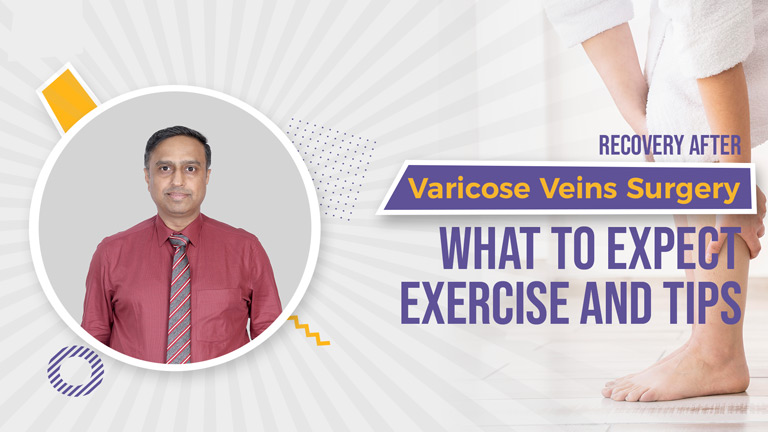Varicose veins can be more than just a cosmetic concern; they can cause discomfort, and pain, and even pose potential health risks. Varicose vein surgery is a common and effective solution, providing relief from symptoms and improving overall vascular health. Recovering from varicose vein surgery involves specific expectations at home and tips for a smoother healing process. Let’s discuss some tips and exercises during the recovery process for a smooth journey back to wellness.
What to Expect at Home Post-Varicose Vein Surgery:
Pain and Discomfort: Mild to moderate pain, swelling, and bruising are common initially. These typically improve over time.
Mobility: You’ll be encouraged to move and walk soon after surgery to prevent blood clots and promote circulation.
Compression: Wearing compression stockings as advised helps reduce swelling and supports blood flow.
Activity Restrictions: Avoid heavy lifting, strenuous exercise, and prolonged standing for a few weeks.
Follow-up Appointments: Regular visits to your doctor for wound checks and progress assessments are important.
Scar Healing: Incision scars will fade over time; follow scar care instructions.
surgery
Recovery Tips for Speed and Smooth Recovery from Varicose Vein
Follow Instructions: Adhere to the surgeon’s guidelines for medication, wound care, and activity restrictions.
Compression: Wear prescribed compression stockings consistently to minimize swelling and improve circulation.
Healthy Diet: Consume nutrient-rich foods to support healing, reduce inflammation, and aid circulation.
Hydration: Stay hydrated to prevent blood clots; aim for adequate water intake.
Walking: Engage in regular short walks to aid circulation and prevent complications.
Elevate Legs: Elevate legs when resting to reduce swelling.
Avoid Smoking: Smoking hinders circulation; quitting enhances healing.
Weight Management: Maintain a healthy weight to reduce strain on veins and promote overall vascular health.
Compression stockings: Speed up the varicose vein surgery recovery
Compression stockings are vital after varicose vein surgery. These specialized stockings apply controlled pressure to the legs, enhancing blood circulation and preventing blood pooling. This reduces swelling, discomfort, and the risk of blood clots. Compression stockings also aid in healing by supporting the weakened veins post-surgery, promoting optimal recovery. Wearing them as recommended by your healthcare provider, especially during the initial days after surgery, helps minimize complications, supports overall vascular health, and contributes to a smoother and more comfortable healing process.
When can I start physical activity after varicose vein surgery?
The timing to resume physical activity after varicose vein surgery depends on the type of surgery performed, your overall health, and your surgeon’s recommendations. Generally, gentle walking can often begin within a day or two after surgery to promote circulation and prevent blood clots. However, strenuous exercises and activities that strain the treated area should be avoided for a few weeks to allow healing and minimize the risk of complications. Always follow your surgeon’s advice and gradually reintroduce physical activities, ensuring you don’t overexert yourself. It’s essential to prioritize your body’s healing process to achieve a successful recovery.
What exercises can I do at Home After Varicose Vein Surgery?
After varicose vein surgery, engaging in gentle exercises at home can aid in your recovery by promoting circulation, reducing swelling, and enhancing overall mobility. Here are some safe and effective exercises you can consider:
Ankle Pumps: Sit or lie down with your legs extended. Gently flex and point your ankles, moving your feet up and down. This helps promote blood circulation in your lower legs.
Calf Raise: Stand near a sturdy support (such as a countertop or chair back). Rise onto your toes, lifting your heels off the ground, then lower them back down. This gentle exercise strengthens calf muscles and supports circulation.
Seated Marches: Sit in a chair and lift one knee towards your chest, then lower it. Alternate legs in a marching motion. This exercise aids circulation and engages your leg muscles.
Knee Extensions: Sit in a chair with your legs extended. Slowly lift one leg straight out in front of you, then lower it back down. Alternate legs. This exercise helps with knee mobility and circulation.
Leg Slides: Lie on your back with your legs extended. Gently slide one heel up toward your glutes, then extend it back down. Repeat with the other leg. This exercise promotes leg movement and circulation.
Deep Breathing Exercises: Sit or lie down comfortably. Inhale deeply through your nose, allowing your abdomen to rise. Exhale slowly through your mouth. Deep breathing helps oxygenate your blood and supports relaxation.
Ankle Circles: Sit or lie down with your legs extended. Slowly rotate your ankles in circular motions, first in one direction and then the other. This improves ankle flexibility and circulation.
Wall Sit: Stand with your back against a wall and slide down into a squatting position with your knees bent at a 90-degree angle. Hold for a few seconds, then stand back up. This exercise gently engages your leg muscles without putting excessive strain on them.






